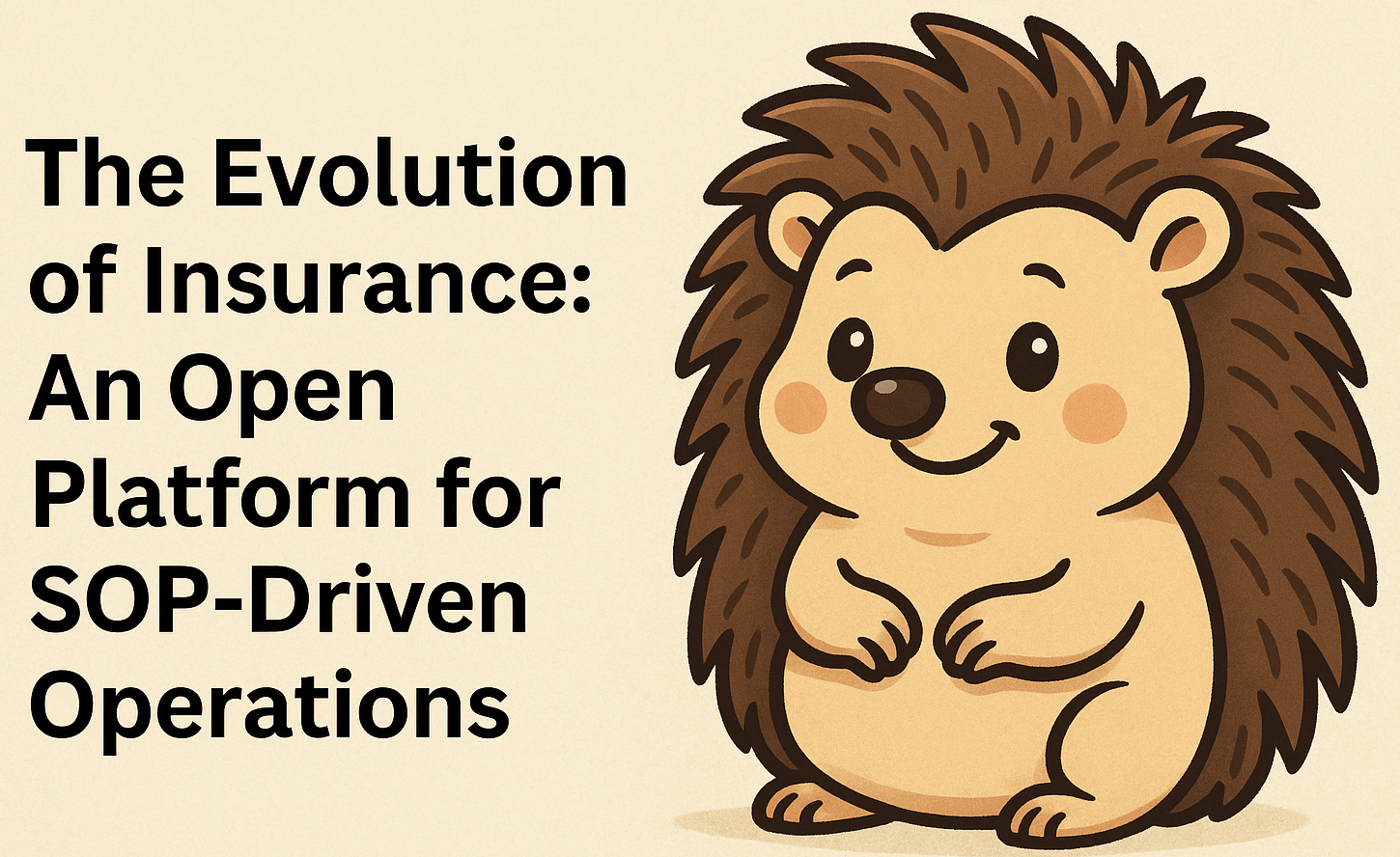Build or Buy? Insurance Core Platforms

Hi there! Junixy the tech-loving hedgehog here! Welcome to my breakdown of the modern "build vs. buy" decision in insurance technology. With focus on core systems like policy administration and claims management. We’ll dive into how AI tools and low-code platforms have changed the landscape, look at when to build, when to buy, and when to use a hybrid (API-driven) approach, and break down the pros and cons so you can choose the path that’s best for you.
The Changing Time-to-Market Equation
Old Thinking:
For a long time, buying a vendor solution, like a Policy Administration System (PAS) or claims management platfor, was considered the fastest route to market.
Reality Check:
Even with a vendor product, you often face several months of discovery, configuration, data migration, integration, compliance checks, training, and user acceptance testing. This can result in a 3-6 month onboarding process, which may be too slow in today’s fast-paced insurance environment.
AI-Accelerated Building: A Game-Changer
What’s New?
Modern AI code generation, low-code/no-code platforms, and cloud-based development frameworks allow a very small team, sometimes just one or two tech-savvy people, to build a basic PAS or claims workflow engine in a matter of weeks.
How It Works:
- AI Tools: They can write boilerplate code, integrate APIs, and generate initial user interfaces.
- Low-Code Platforms: Non-technical team members can help design workflows and features visually, speeding up iteration.
Result:
What once required dozens of engineers and months of effort can now be done faster and cheaper. Some teams get a minimal viable system running in about a month and then continuously improve and expand it.
Re-Analyzing Build vs. Buy in Light of AI
When to Consider Building (with AI and Low-Code):
- Time-to-Market Advantages: If vendor onboarding drags on for months, building in-house with AI can get you to market faster.
- Unique or Flexible Workflows: If your product or claims process changes rapidly or serves a niche market, building lets you adapt on the fly.
- Small but Capable Team: A small, skilled crew can leverage AI to reduce manual coding and tap into serverless cloud platforms for infrastructure.
- Differentiation Needs: Creating your own system avoids "cookie-cutter" vendor templates, letting you stand out with advanced features like AI-driven underwriting or claims chatbots.
- Cost-Efficiency at Scale: Pay-as-you-go cloud services and reduced developer hours can make building more cost-effective in the long run.
Pros of Building:
- Customization & Control: Full flexibility over features and workflows.
- Faster Iteration with AI: Rapidly test and refine functionalities.
- Long-Term Value: You own the intellectual property, making your system a unique, strategic asset.
- Potentially Lower Costs Over Time: Reduced vendor fees and the ability to scale costs gradually.
Cons of Building:
- Initial Complexity: Even with AI and low-code, building a compliant insurance system takes thoughtful design.
- Resource Needs: You need at least a small team familiar with digital tools. No matter how good the AI is, some technical know-how helps.
- Responsibility for Compliance & Maintenance: You must ensure regulatory compliance, security, and ongoing maintenance yourself.
When Buying from a Vendor Still Makes Sense
When to Consider Buying:
- Complex, Multi-Jurisdictional Compliance: If you’re launching across many states or countries, each with unique rules, a vendor solution might be pre-equipped for this complexity.
- Turnkey, No-Engineering Approach: If you lack tech leadership or don’t want to manage even an AI-driven build, a fully vendor-managed solution might be more convenient.
- Established Vendor Ecosystems: Big-name platforms come with built-in integrations (rating engines, reporting solutions, data vendors), saving you the trouble of building integrations from scratch.
Pros of Buying:
- Compliance & Regulatory Head Start: Vendors may have out-of-the-box modules for regulatory reporting, audit trails, and compliance frameworks.
- Lower Internal Technical Overhead: You rely on the vendor’s infrastructure, security, and maintenance.
- Pre-Integrated Ecosystem: Quickly tap into established partner networks and tools.
Cons of Buying:
- Longer Initial Setup than Expected: Despite the label "ready-made," vendor implementations still take time (3-6 months from what I have seen).
- Recurring Costs & Fees: You pay license and support fees, which can add up long-term.
- Limited Differentiation & Flexibility: Vendor solutions can be rigid, making it harder to innovate or adapt workflows quickly.
- Less IP Ownership: You’re building on someone else’s foundation, not creating unique assets.
- Roadmap: You are bound my the vednor's roadmap, if you need a new feature quickly then you are going to have to get in line with all their other customers.
The API-Driven Middle Ground
What Are API-Driven Vendor Solutions?
These offer core insurance capabilities (e.g., policy issuance, claims handling) accessible via APIs. Think of it as buying a powerful "engine" and then using AI tools and low-code platforms to build your own custom interface and workflow around it.
Why This Hybrid Approach?
- Accelerated Development with AI: Quickly layer unique features on top of a stable vendor backend.
- Faster Customization & Differentiation: You’re not stuck with the vendor’s UI. Add AI fraud detection, chatbots, or analytics easily.
- Reduced Cost & Risk: You rely on the vendor for compliance and system stability while focusing on what sets you apart.
- Scalability & Incremental Updates: Grow at your own pace. AI-assisted coding makes adding new features or integrations simpler.
Pros of API-Driven Solutions:
- Balance of Speed & Flexibility: Start with a proven engine, then customize.
- Strong Vendor Foundation: Compliance and stability are already handled.
- Room to Innovate: Add unique features and integrations without starting from scratch.
Cons of API-Driven Solutions:
- Vendor Dependency: If the vendor changes APIs or pricing, you must adjust.
- Recurring API Usage Costs: You’ll have ongoing fees tied to API usage.
- Integration Effort: Connecting your custom layers to the vendor engine still requires careful planning.
- Limited Core Control: The vendor still controls the underlying system updates and performance.
Considering Low-Code in the Mix
Why Low-Code?
If you lack a large developer team, low-code platforms enable domain experts, like underwriters or claims managers, to design workflows visually. AI tools can help fill in the code where the platform’s standard tools fall short.
Pros of Low-Code:
- Fast Prototyping: Create and iterate on workflows quickly.
- Wider Team Involvement: Non-technical staff can contribute to system design.
- Speeds Time-to-Market: Often faster than traditional coding or waiting on a vendor.
Cons of Low-Code:
- Complex Logic Limitations: Truly custom functionality might be harder to implement.
- Dependence on Platform’s Capabilities: You might be constrained by what the low-code tool can do out-of-the-box.
- AI Intervention Needed: AI can help extend capabilities, but that adds another layer of complexity as you grow.
Why Not Outsource? The Value of Keeping Development In-House
Retaining Strategic Knowledge:
When you keep core development in-house, you maintain full visibility and understanding of your system’s inner workings. Instead of relying on a third-party firm that may treat your project as just another contract, your own team gains intimate knowledge of the codebase, workflows, and integration points. Over time, this institutional expertise becomes invaluable—it helps you respond to unexpected challenges faster and guides more strategic decision-making.
Faster Innovation and Iteration:
A team that’s part of your organization, sharing your vision and goals, can pivot and adapt more quickly. Whether it’s adding an AI-driven underwriting feature or testing a new claims workflow, an in-house team can iterate rapidly without waiting on an external partner’s availability. This speed of innovation is a huge advantage when market conditions change, new regulations emerge, or your product strategy evolves.
Long-Term Cost Efficiency:
While outsourcing may seem cheaper at first glance, ongoing dependency on external contractors can add up. Each new feature request, bug fix, or compliance tweak might involve additional fees and negotiation. In contrast, investing in your own talent pays dividends over time. Your team gains experience, productivity improves, and you avoid the constant back-and-forth that often comes with outsourcing arrangements.
Strong Cultural Alignment and Ownership:
An in-house team is naturally aligned with your company’s culture, values, and goals. They feel greater ownership, accountability, and pride in the product they’re building. This often translates to higher-quality work, better communication across departments, and systems that better reflect your brand’s unique vision. Instead of a transactional relationship, you get a dedicated group of people who care deeply about the success of your insurance technology platform.
Cost, Value, and Long-Term Strategy
Short-Term View:
- Building with AI: Lower upfront dev costs, smaller teams, rapid launch.
- Buying from a Vendor: Higher initial fees and time-to-implement, but potentially less internal complexity.
Long-Term View:
- Building with AI: You own the system and its IP, maintaining full control as you scale and adapt.
- Buying from a Vendor: Stable and supported, but you may end up with recurring fees, less differentiation, and lower unique value.
Summary: What to Consider When?
Consider Building (with AI and Low-Code) if:
- You can leverage AI for fast prototyping and continuous improvement.
- You have at least a small, capable team comfortable with digital tools.
- Long-term differentiation and IP ownership matter to you.
- The vendor timeline isn’t meaningfully faster and you need flexibility.
Consider Buying if:
- Your compliance and integration needs are complex and urgent, and the vendor is truly plug-and-play.
- You have no internal technical capacity and prefer a turnkey solution.
- You’re comfortable paying for ongoing vendor services in exchange for simplicity and predictability.
Consider API-Driven Solutions if:
- You want the vendor’s stable core but still seek the flexibility to add unique features.
- You’re okay with a balanced approach—paying for the engine and building your own "car" around it.
- You’re prepared to manage some integration work while benefiting from vendor compliance and infrastructure.
Some of My Favorite Systems
If you’re exploring policy administration systems and claims platforms from vendors as opposed ot building yourself, here are a few standout platforms that I recommend adding to your list to review:
ChainThat Beyond Policy Administration (BPA): Known for its advanced digital platform, ChainThat offers a seamless way to integrate and manage your policy processes while enabling quick product rollouts. Learn more here.
Five Sigma offers a cutting-edge claims management platform powered by AI and data-driven insights. Designed to optimize claims processes, Five Sigma helps insurers improve operational efficiency, reduce costs, and enhance customer experiences. Its cloud-native platform supports automation and real-time analytics, ensuring smarter and faster decision-making throughout the claims lifecycle. Learn more about Five Sigma here.
Insly: A flexible, cloud-based solution that simplifies managing policies, clients, and claims, with integration capabilities tailored to your needs. Explore Insly.
Socotra: This cloud-native core platform is built for modern insurance needs, providing policy administration, billing, and claims management with open APIs for easy integration. Discover more about Socotra.
Thanks for joining me, Junixy, on this deep tech dive! The "build vs. buy" decision is more balanced than ever, thanks to AI and low-code tools. It’s not just about who gets you to market fastest—it’s about long-term control, differentiation, cost structure, and how ready you are to take on technical challenges. Ultimately, the best choice depends on your unique needs, capabilities, and strategic vision. Good luck!


